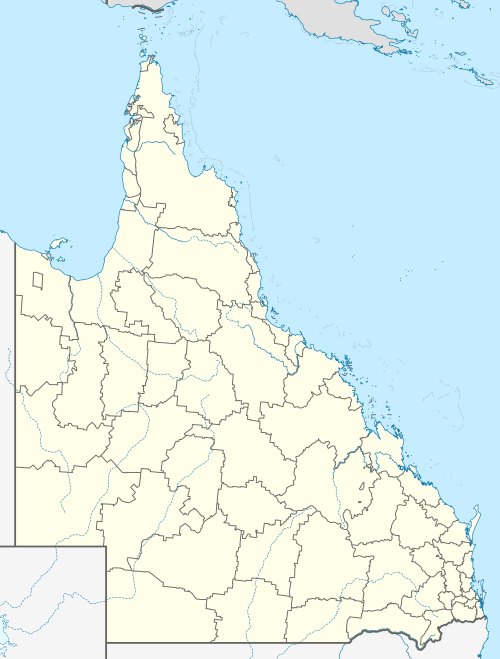Badu Island
Badu or Badu Island (Mulgrave Island), pronounced ['ba:du:] in English, in Kala Lagaw Ya Badhu [bad̪u], is an island in the Torres Strait 60 kilometres (37 mi) north of Thursday Island, Queensland, Australia.[2] Badu Island is also a locality in the Torres Strait Island Region,[3] and Wakaid is the only town, located on the south-east coast.[4] This island is one of the Torres Strait Islands. The language of Badu is Kala Lagaw Ya.
| Badu; Badu Island Queensland | |
|---|---|
.png) A satellite image of Badu Island | |
 Badu; Badu Island | |
| Coordinates | 10.1202°S 142.1394°E |
| Population | 813 (2016 census)[1] |
| • Density | 8.050/km2 (20.848/sq mi) |
| Postcode(s) | 4875 |
| Area | 101.0 km2 (39.0 sq mi) |
| Time zone | AEST (UTC+10:00) |
| LGA(s) | Torres Strait Island Region |
| State electorate(s) | Cook |
| Federal Division(s) | Leichhardt |
The Mura Badulgal (Torres Strait Islanders) Corporation administers land on behalf of the Badulgal people. The Badulgal people’s ownership of Badu and surrounding islands in the Torres Strait was recognised in a native title determination on 1 February 2014, when the Queensland Government handed over to the Badhulgal traditional owners freehold title to 9,836 hectares (24,310 acres) of land.
In the 2016 census, Badu Island had a population of 813 people.[1]
History
Kala Lagaw Ya (also known as Kala Lagaw Ya, KLY and Gumulgal) is one of the languages of the Torres Strait. Kala Lagaw Ya is the traditional language owned by the Western and Central islands of the Torres Strait. The Kala Lagaw Ya language region includes the landscape within the local government boundaries of the Torres Shire Council.[5]
In 1606, Luís Vaz de Torres sailed to the north of Australia through Torres Strait, navigating it, along New Guinea's southern coast.[6]
Warfare (feuding, headhunting), farming, fishing, canoe building, house building, turtle and dugong hunting and a host of other activities were the main occupations of Badu men until the 1870s. However, headhunting ceased with the adoption of Christianity.[7]
Pearlers established bases on the island during the 1870s and by the early 1880s the islanders were becoming dependent on wages earned as lugger crews. At the same time, the first missionaries arrived. At the peak of the shell industry in the late 1950s, the Badu fleet of 13 boats employed a workforce of 200 providing work for many men, even from other islands as well. Once the shell trade declined, many people moved to the mainland for work [8]
Badu Island State School opened on 29 January 1905.[9]
Native title
On 1 February 2014 the Queensland Government handed over to the Badhulgal traditional owners freehold title to 9,836 hectares (24,310 acres) of land on Badu Island,[10] ending a struggle for recognition dating back to 1939. The title deed was handed over by David Kempton, Assistant Minister for Aboriginal and Torres Strait Islander Affairs, to Badu Elder Lily Ahmat at a ceremony on the island.[11] An Indigenous Land Use Agreement (ILUA) was signed on 7 July 2014.[12]
The Mura Badulgal (Torres Strait Islanders) Corporation (an RNTBC) administers land on behalf of the Badulgal people.[10][12]
Economy
Infrastructure on Badu Island consists of:
- Badhulgaw Kuthinaw Mudh Art Centre
- Airport
- Regional Council Office
- State School (Years 1 to 7)
- Health Centre with permanent doctor
- Two grocery stores
- Indigenous Knowledge Centre in Nona Street, operated by the Torres Strait Island Regional Council[13]
- Post Office
- Centrelink Agency
- Football Field
- Motel
- J&J Supermarket Locally Owned
A number of other locally owned run businesses are in operation at Badu including live seafood exports.
Notable people
Notable people who are from or who have lived on Badu Island include:
- Ethel May Eliza Zahel (1877–1951), teacher and public servant.[14]
- Tanu Nona (1902-1980), pearler and politician[15]
References
- Australian Bureau of Statistics (27 June 2017). "Badu Island (SSC)". 2016 Census QuickStats. Retrieved 20 October 2018.

- "Badu Island - island in Torres Strait Island Region (entry 1216)". Queensland Place Names. Queensland Government. Retrieved 20 March 2014.
- "Badu Island - locality in Torres Strait Island Region (entry 46705)". Queensland Place Names. Queensland Government. Retrieved 5 November 2019.
- "Wakaid - population centre in Torres Strait Island Region (entry 10263)". Queensland Place Names. Queensland Government. Retrieved 8 January 2020.
-

- "ADBonline.anu.edu.au". ADBonline.anu.edu.au. Retrieved 14 July 2011.
- Beckett 1987, pp. 147ff.
- 2006 Bruno David and Marshall Weisler, KURTURNIAIWAK (BADU) and the Archaeology of Villages in Torres Strait Australian Archiology, No. 63,December
- "Opening and closing dates of Queensland Schools". Queensland Government. Retrieved 18 April 2019.
- "Badu Island traditional owners granted freehold title". The Queensland Cabinet and Ministerial Directory. 1 February 2014. Retrieved 26 July 2020.
- Torres News, 10–16 February 2014
- "Agreements, Treaties and Negotiated Settlements project". ATNS. 7 July 2014. Retrieved 26 July 2020.
- "Badu Island Indigenous Knowledge Centre". Public Libraries Connect. 28 August 2017. Retrieved 5 February 2018.
- Lawrie, Margaret (1990). "Zahel, Ethel May Eliza (1877–1951)". Australian Dictionary of Biography. National Centre of Biography, Australian National University. Retrieved 22 December 2018.
- "Biography - Tanu Nona". Australian Dictionary of Biography. Retrieved 23 January 2020.
Bibliography
- Dixon, Robert (2013). "Cannibalising indigenous texts:headhunting and fantasy in Ion L. Idriess's Coral Sea Adventures". In Creed, Barbara; Hoorn, Jeanette (eds.). Body Trade: Captivity, Cannibalism and Colonialism in the Pacific. Routledge. ISBN 978-1-136-71308-8.CS1 maint: ref=harv (link)
- Beckett, Jeremy . (1987). Torres Strait Islanders: custom and colonialism. Cambridge University Press. ISBN 978-0-521-37862-8.CS1 maint: ref=harv (link)
- Moore, David R. (1979). Islanders and Aborigines at Cape York. Australian Institute of Aboriginal Studies. ISBN 978-0-855-75082-4.CS1 maint: ref=harv (link)
- Shnukal (1), Anna (2008). "Traditional Mua" (PDF). Memoirs of the Queensland Museum. 4 (2): 7–33.CS1 maint: ref=harv (link)